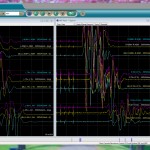SSEP monitoring enables the assessment of the dorsal column and the function of the lateral sensory tract. It may also detect changes in function of the anterior motor tracts by stimulating mixed sensorimotor peripheral nerves. It has always been the standard for intraoperative monitoring. However, despite normal SSEPs, significant motor deficits have been seen in patients undergoing spinal surgery and so MEPs were developed to monitor the motor pathways. It is important to know that physiological changes to the patient, such as blood loss and low blood pressure, can severely diminish the motor evoked responses. Use of anaesthetic gases will also reduce or even block the motor signals.
Technique
MEPs (TceMEP) are induced by trans cranial electrical stimulation of the motor cortex using electrodes placed on the scalp of the patient. Recordings are usually obtained as potentials in various muscles. MEPs can reliably be obtained since the signal response is usually large. It is a useful way to monitor motor pathway function and is now used as a standard form of monitoring during spinal surgery alongside SSEP.








